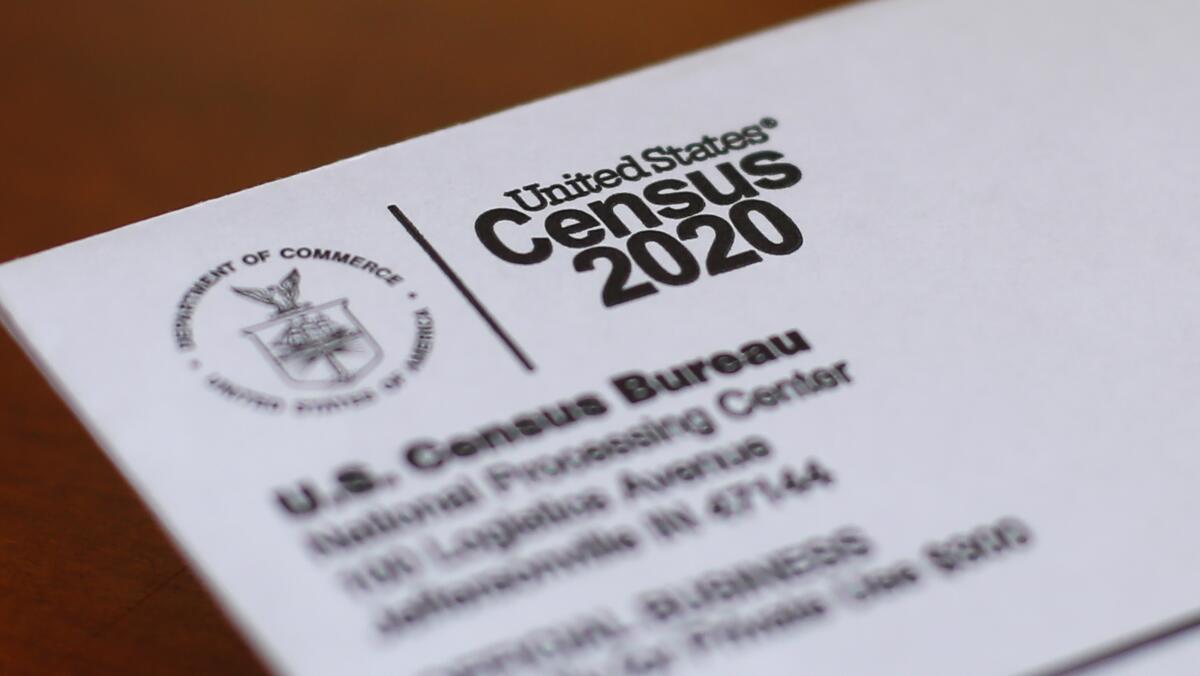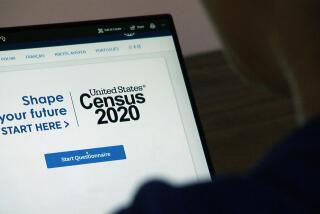Census Bureau works to improve confidence in 2020 head count

- Share via
The Census Bureau is looking to improve trust in the numbers it gathered during the 2020 census by fixing problems caused by the unprecedented challenges of conducting a U.S. head count during a pandemic, natural disasters and efforts by the Trump administration to politicize the process.
Demographers, advocates and others who rely on census data are watching carefully and like what they see so far, but they want to monitor how the fixes are implemented before passing judgment.
The Census Bureau announced last week that it will break with past practice and not rely on 2020 census data solely as the basis for creating its annual estimates of the U.S. population. The estimates are used to help distribute $1.5 trillion in federal funding each year and measure annual population change through 2030. For the first time, bureau statisticians will blend some of the 2020 census numbers with other data sets for the base when it releases numbers for 2021 and possibly 2022.
Statisticians wanted time to evaluate the census data to make sure it is usable for the estimates, said Christine Hartley, a Census Bureau official.
“Because of how the pandemic impacted census field operations, there also were many questions about quality,” Hartley said. “We needed some kind of solution that didn’t fully rely on the 2020 census data.”
Former President Trump faces a number of investigations beyond the Jan. 6 inquiry that could come to a head in the coming weeks and the new year.
The Census Bureau has also proposed another fix, which would allow states, municipalities and tribal nations for the first time to challenge results on the numbers of people living in dorms, prisons, nursing homes and other places where people live in group quarters. These places became especially difficult to count after students on campus were sent home when the pandemic began in the U.S. in March 2020, and prisons and nursing homes went into lockdowns against the spread of the coronavirus.
This one-time change, which is expected to be approved by the Office of Management and Budget after a public comment period, is a response to public feedback seeking to expand the scope of challenges to include group quarters “due to the unique circumstances surrounding the 2020 Census,” the Census Bureau said in a statement.
Some experts say the fixes serve as a reality check on a sometimes over-optimistic attitude by bureau officials about a head count that faced formidable challenges and delays caused by the COVID-19 pandemic, wildfires, hurricanes and attempts by the Trump administration to add a citizenship question that failed, but nevertheless may have scared off some people from participating.
Although the Census Bureau has been transparent in releasing quality measures of data gathered in the face of the unprecedented challenges, “in doing so, it always puts the best face possible on what is happening,” said Arturo Vargas, CEO of NALEO Educational Fund.
“I have a saying that, ‘It’s always sunny in Suitland,’” Vargas added, referring to the statistical agency’s headquarters in Suitland, Md. “But there needs to be an acknowledgment that there are challenges even they can’t overcome.”
The changes have mostly been well-received by demographers and advocates. They “can increase accuracy, and that’s a good thing that increases trust,” said Allison Plyer, chief demographer at the Data Center in New Orleans.
Demographer William O’Hare, who has advocated for making sure children are fully counted, said the “blended base” approach would improve estimates for children by using highly accurate birth certificate data. Missed children are a big concern, since an analysis O’Hare did earlier this year showed there was a 4.4% undercount of Hispanic children in the 2020 census.
Concerns about an undercount among Black people, Hispanic people, children and tribal nations are heightened by the risk that those groups could be shortchanged in the distribution of federal funds, some advocates say.
“The National Urban League has every reason to believe that Blacks were undercounted during the 2020 Census at rates exceeding the previous census,” said Marc Morial, the civil rights group’s president and CEO in an email. “It is a GOOD thing that Census is trying to be more transparent (and more is needed), and that we are talking about options and new data sources to address the differential undercount.”
The bureau’s own take on the accuracy of its 2020 census won’t be officially known until next year, when it releases a report card on how good a job it did. Earlier this year, an American Statistical Assn. task force said its review found no irregularities indicating the results were unfit for use in the apportionment of congressional seats, or that they were of lower quality than those in 2010.
An analysis by the Urban Institute, however, found that people of color, renters, noncitizens, children and people living in Texas — the state that saw the nation’s largest growth — were most likely to be missed, though by smaller margins than some had projected for a count conducted under such difficult circumstances.
There are some concerns about the census data that the announced changes won’t fix, such as the Census Bureau’s new privacy technique, which inserts inaccuracies at very small geographic levels to protect the confidentiality of participants such as, say, the only family of a certain ethnicity living in a particular geographic area. Some small town officials are concerned that sparsely populated communities aren’t being described accurately, said Eric Guthrie, senior demographer at the Minnesota State Demographic Center.
In another effort at protecting confidentiality, the Census Bureau is contemplating not including granular data when it releases the next round of 2020 census numbers next year. That data will deal with housing and family relationships, and the bureau says it has taken great pains to produce accurate information while protecting the privacy of participants in the nation’s head count.
Guthrie recently told a National Academies committee studying census data quality that there’s a lot of skepticism among small town officials he’s spoken to. He said many of them mobilized considerable resources to help with the count and now feel betrayed that they won’t get usable data at the smallest geographies.
“This is the one shot they get and they feel like they have been robbed of it,” Guthrie said. “There’s not a basis of trust anymore.”
More to Read
Sign up for Essential California
The most important California stories and recommendations in your inbox every morning.
You may occasionally receive promotional content from the Los Angeles Times.











